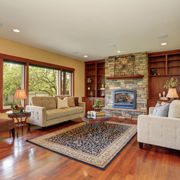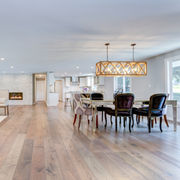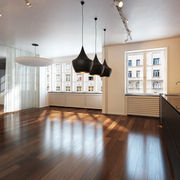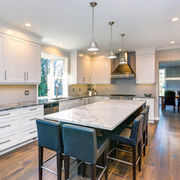top of page
Hardwood is a classic flooring choice that never goes out of style thanks to its natural look, durability, longevity, low-maintenance and sound reducing acoustical properties. With the many styles on the market such as elegant, traditional, modern, contemporary and rustic - there’s definitely something to suite every individuals design needs.
Choosing A Hardwood Floor Begins With Your Personal Style
Engineered Or Solid Hardwood Which One Is Better?
Engineered Hardwood
Engineered hardwood is constructed of multiple layers of wood. The top layer, a beautiful hardwood veneer followed by supportive layers which make up the core. The core consist of either plywood, particle board or fiberboard/MDF. The plywood core is superior and made of genuine wood, the grain of each layer runs perpendicular to the next which makes it very stable and provides better properties than solid wood, while preventing unwanted warping and shrinkage.

Engineered Hardwood
It’s important to know that most of the engineered hardwood flooring you find in retail stores and big box warehouses today are NOT genuine but actually low quality “fiberboard” or “sawdust” cores hidden behind an appealing hardwood veneer. The quality and longevity of these lower quality cores varies drastically from the original plywood core innovation. Contact Us today and ask about our top quality engineered hardwood. It’s an excellent choice!
Solid Hardwood
Solid hardwood is a plank that has been milled from a single piece of hardwood and can be sanded and refinished many times. Available in a multitude of species, most often red or white oak, milled to 5/8” or 3/4” thick and most often nailed down to a plywood subfloor. However, solid wood is a living breathing material that hates water and is susceptible to changes in humidity and must be acclimated.

Solid Hardwood
Solid Wood Flooring Acclimation
Solid hardwood is hygroscopic. This means that it will take on moisture from the environment it’s in. Taking on or losing too much moisture will cause the hardwood to change. It can expand, shrink, check or split because of excessive moisture changes. When wood flooring takes on too much moisture, individual boards will start to expand in width. This can cause boards to appear cupped or swollen. Boards can also begin to push against the fasteners in the floor and eventually cause squeaks or loose boards. When wood flooring loses moisture and becomes too dry, boards will begin to shrink in width, causing gaps to appear between boards. For this reason, solid hardwood must acclimate to the average normal climate conditions of your home before installation.
There Are Two Common Installation Methods For Hardwood Flooring (Glue Down & Nail Down)
Glue Down Installation
Homes with a concrete subfloor are most often glue down hardwood floors. Gluing hardwood includes pros like giving your floor a solid feel and sound as well as being least likely to have deflection between flooring and subfloor over nailing hardwood and you’re not likely to hear squeaks develop over time. The glue elasticity allows your floors to contract and expand naturally regardless of the season. It’s stable and considered to be the most permanent installation method.
Nail Down Installation
Homes with a wood subfloor are most often nail down hardwood floors. Nailing down hardwood has a few pros, including it’s faster and considered the most cost-effective installation method. The con to nailing hardwood is that nails can loosen over time due to seasonal expansion and results in squeakiness in the floor.


bottom of page







